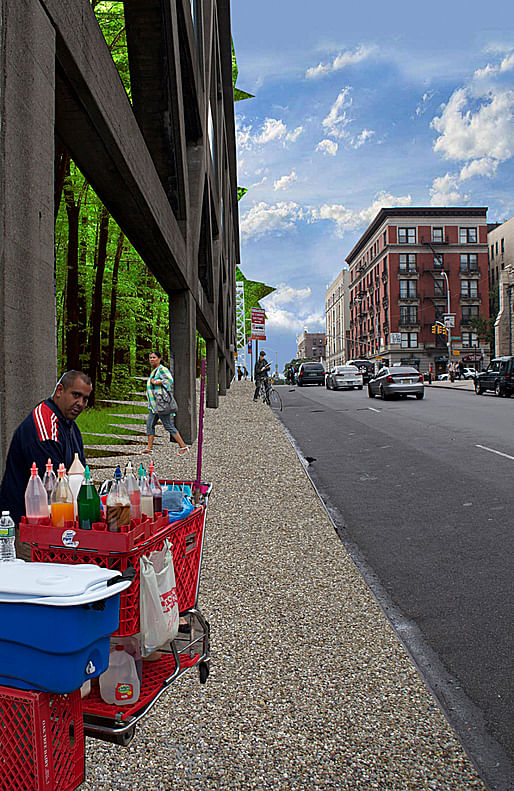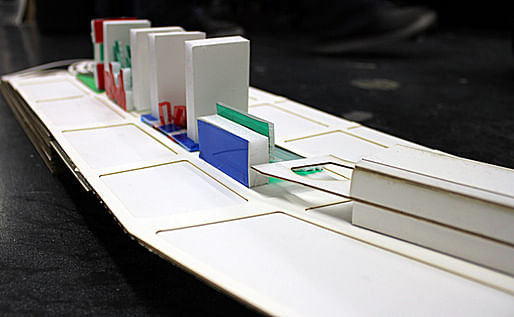

Hi Archinect!
We had our midterm last Wednesday and I am finally rousing myself out of my post-review sloth and pleasure-chasing (and yes, it was glorious) in order to post some images.

I've already posted photos of our site. And you may have seen the video of my critics' public lecture at the GSD.
Our projects are dealing with the leftover spaces, or the "incomplete manifesto" left by the sunken highway and the bridge tower apartments over the I-95 highway in northern Manhattan near the George Washington Bridge. Our task is to design housing for 1000 people as well as whatever other programs we choose. I got interested in the environmental conditions at the site and thought that a project here could be environmentally performative in three ways:
1. Supporting an ecological corridor to allow at least some plant and animal species to live and traverse this part of Manhattan, between the two waterfront parks. [Ecological function, with cultural and recreational benefit if you put a bicycle path within the corridor.]
2. Allowing the site to be agriculturally productive, so that some produce and/or non-edible crops can be grown; this could address some of the "food desert" issues in this neighborhood. [Economic and cultural functions.]
3. Cleaning the air coming up from the highway to alleviate some of the air pollution problems--and maybe this can help with the noise problems from the same highway. [A more technical project with health and happiness benefits.]

[This collage isn't meant to be informative about any specific design proposal, but just kind of a playful thing. But check out this beautiful, giant colonnade and concrete truss by Nervi!]
So my project makes space for the ecological corridor, in a strip running along the south side of the site that makes use of the current sidewalk space and a space gained by de-mapping a lane of street parking. This aspect hasn't yet been developed, beyond setting aside this space.

The urban farming is a bit more developed, as there are outdoor spaces at the east end of the site (the flat park at the foot of a new tower), as well as year-round greenhouse spaces in one of the between-tower sites.

Finally, the air-scrubbing is what has driven much of the design so far. The basic premise is that there are biological filtering systems for cleaning air of carbon dioxide, carbon monoxide, particulates, and VOCs, and I've chosen two of these: one passes air through a bed of compost, and the other passes air through the soil/roots and green parts of certain kinds of plants. Both systems generally rely on fans to pump the air, but suction could also be provided through thermal chimneys, which I thought could be a way to start giving architectural expression to the structures that house these technological systems.
This system can be arranged in different ways, as long as it meets basic requirements in terms of thermal chimney effects, light for the plants, space for the two biofiltration systems, and a somewhat streamlined passage of air up from the highway.
So it's about a mega-system, not a single mega-form.
I've started to develop four different formal expressions for this system, each using these same parts to create different spatial conditions that respond to the context at each part of the site. These four sub-sites are as below, and these go from the west side of the site--where a connection three stories up is made with the existing Nervi bus terminal--to the very east end--where a "tower in the park" adds a fifth tower to the existing four and would serve to announce the project to those approaching from the east. The two middle sites are located between the existing bridge tower apartments and my aim is to establish two very different ways of fitting in to this strange interstitial space.
So, going from west to east (or left to right on the board below), we have: "hill building," "greenhouse village," "urban orchard," and "tower in the park." I got roasted for the "village" aspect of the "greenhouse village" so I'm rethinking that.

Below are some sections of these four sites, going from east to west. Purple is housing, pink is live-work, orange is a market, and green is all the air-scrubbing stuff.

And here are some other diagrammatic views.

And some early thoughts for the "urban orchard" space. I'm rethinking the smokestack/skyline-like form of the tall thermal chimneys here, but the idea would be that they'd form an 8' thick facade that would be penetrated at intervals by balconies and sunrooms for the apartments behind them.


And the model. Long-time readers may remember my fine model craftsmanship from such hits as the saltine cantilever and the happy-face scale figures. Well, this is just one small step up from that but still has a very advanced-kindergarten kind of feel.



Our critics were Megan Born, Clifton Balch, John Hong and Jinhee Park, and Shih Fu Peng. Marion and Michael did a good job of picking people who would engage with the questions that we're grappling with, rather than trying to re-invent the whole premise of the studio (which can happen...as you all know). Anyways, they were on board with the overall premise; and I just (ha! "just") have to work on the formal expression of the four sites relative to each other, getting the system to be more systematic, and getting all the housing in there in a way that is consistent with the rest of the project.
But I would love to hear your thoughts too!
All for now! Thanks for reading.
Lian
This blog was most active from 2009-2013. Writing about my experiences and life at Harvard GSD started out as a way for me to process my experiences as an M.Arch.I student, and evolved into a record of the intellectual and cultural life of the Cambridge architecture (and to a lesser extent, design/technology) community, through live-blogs. These days, I work as a data storyteller (and blogger at Littldata.com) in San Francisco, and still post here once in a while.



No Comments
Block this user
Are you sure you want to block this user and hide all related comments throughout the site?
Archinect
This is your first comment on Archinect. Your comment will be visible once approved.